The world before mobile communications: pagers
Remember the movie "Bruce Almighty"? Where did God send the protagonist messages on a small electronic device? Today we decided to recall the pager - a symbol of the wealth in Russia of the nineties and the elder brother of modern mobile phones.

Frame from the film "Bruce Almighty" (2003)
Thirty years old may be ridiculous from this question, but today's schoolchildren no longer know that there was such a thing. A pager is a miniature radio that allows you to receive short messages at a specific frequency. All messages are sent through the operator: you call the operator, dictate the message and the number of the subscriber. And the operator sends a message to the addressee. Later, bilateral pagers appeared that allow you to communicate without intermediaries.
Motorola introduced the first pager in 1956. He received signals within a radius of 200 meters and gave a short sound signal, for which he received his second name - beeper, from the English Beep. Then pagers were used to equip hospitals, and with the development of technology and an increase in range, they found application in police stations and rescue services.
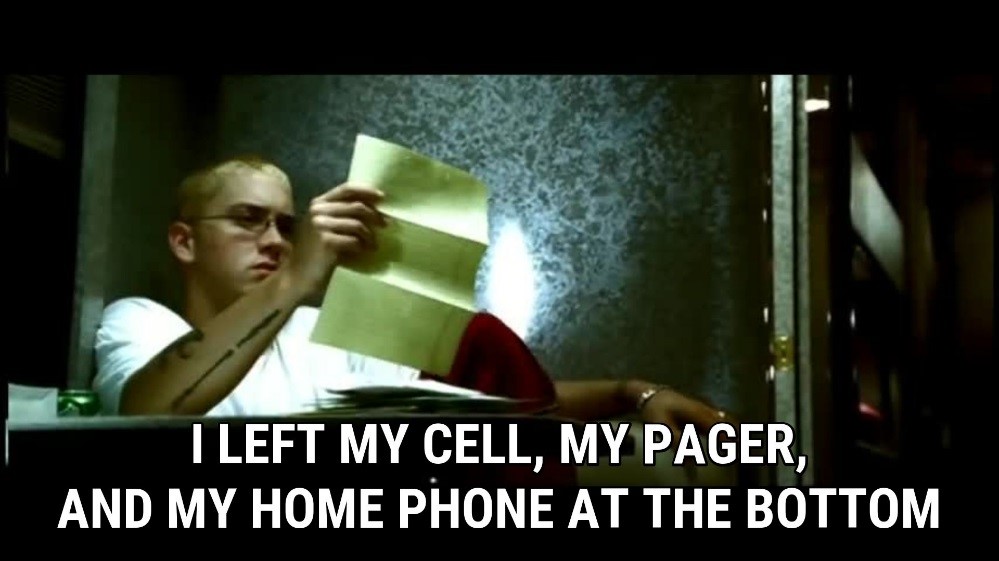
Shot from Eminem's “Stan” (2000) video
But miniature devices won worldwide popularity only in the mid-80s, when in 1986 Motorola launched Bravo, the most popular pager model with three buttons and a three-line display.
In 1996, almost 100 million people used pagers in the world.
It is based on a radio tuned to a specific paging company frequency and the format of messages received. In addition, there was a decoder, micro-computers - the “brains” of the pager, a few buttons, and later a display.
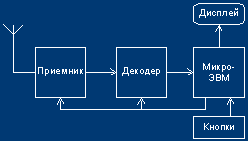
Pager block diagram
Each pager has built-in cap codes - physical addresses, personal and group. A personal address is unique for each device, and group addresses are the same for all pagers with a common language encoding. All cap codes are stored in the operator’s database. When a client calls the operator and calls the subscriber number, the operator finds his personal cap code and sends a message.
In different countries, paging communication works with different formats. The most common is the POCSAG protocol, developed in the UK in 1978. It has been successfully applied so far, the message rate is 512, 1200 or 2400 bps.
Motorola created the faster protocol Flex in 1993. It used synchronous data transmission, messages were transmitted at a speed of 1600, 3200 and 6400 bps. Flex can support more than 5 billion addresses - that's twice as much as POCSAG.
Especially for Europe, the ERMES protocol was developed, which is fully compatible with the GSM communication standard and adapted to other European cellular network designs. The format was created as part of the creation of a pan-European personal radio call system and worked in the frequency range 169.4 - 169.8 MHz.
There were three main types of devices: tonal - pagers of the first generation, they are also beeper, digital - transmitted information only in digital form and text - with which it was possible to send messages.
The last word in the development of paging was teasers: equipped with a qwerty-keyboard, with two-way communication, they allowed you to communicate without intermediaries. Motorola, the first Tager, released Motorola in conjunction with SkyTel, the US national operator, in 1996. But even then it was clear that the century of small squeaking devices was ending - the world was actively conquering mobile communications.
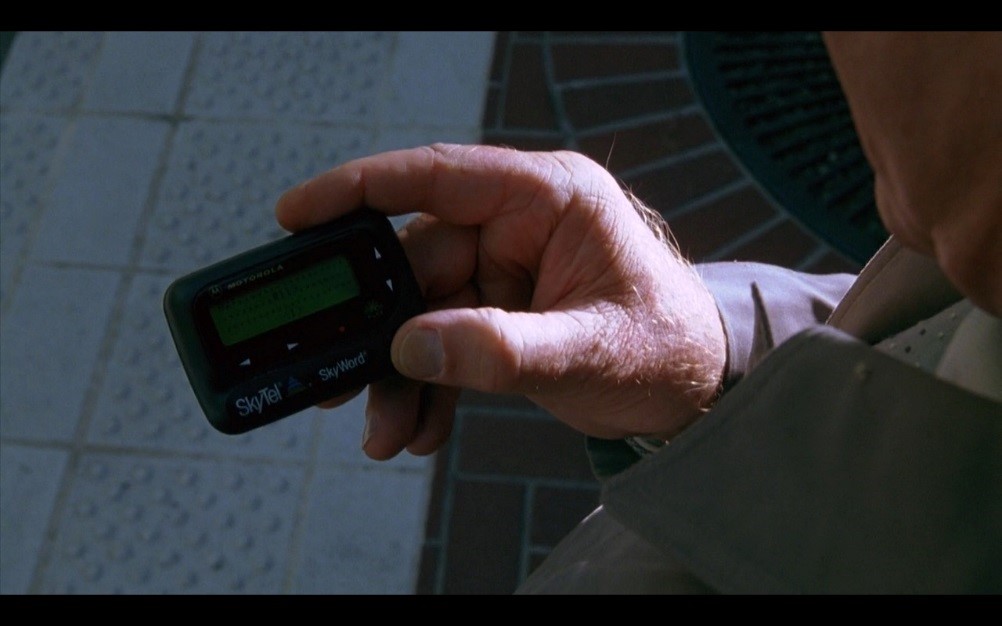
Frame from the film "Zero Effect" (1998)
Paging communication appeared in the USSR by the end of the 60s - it was used by employees of the ambulance and some government agencies. In 1979, in preparation for the Olympics-80, the British company Multitone deployed the Radio Search network in Moscow, which operated at a frequency of about 43 MHz. She solved the problem of quick transfer of commands to the executors of celebrations and coordinated their actions.
The general public did not use pagers until the collapse of the Soviet Union.
In the midst of the 90s, it was a symbol of a prosperous life: bulky mobile phones with their astronomical prices ( Nokia Mobira cost $ 2000 and weighed three kilograms), could afford units, and pagers spread wider. But the service was still expensive: connection about $ 350, and a monthly fee of $ 50-70. The first Russified pager was launched on the market the already mentioned Multitone - the MIT-472 model cost $ 380 and could receive messages up to 7500 characters in length. Theoretically, you can send this text to such a device - its volume is slightly more than 7 and a half thousand characters. The display simultaneously displayed a maximum of 94 characters.
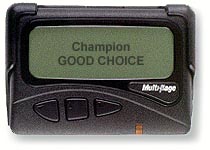
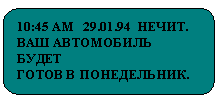
If there was no money, but wanted to stand out, those who wanted to buy an electronic watch, similar to a pager, and proudly hung them on the belt.
There were dozens of paging companies all over the country: there were no federal operators, and the number of regional ones varied greatly depending on the region.
The quality of communication depended on the number of transmitters from the operator, their power and location. For example, transmitters with a power of 350 watts and a coverage radius of 70-80 km worked on the Ostankino tower. In the late 90s, Motorola transmitters or their domestic counterparts, the ZhM-300, were used. Sometimes they put amplifiers.
Each operator worked at its own frequency. The company bought pagers programmed for this frequency and tuned transmitters to it. Or you could order free pagers, and then tune them to your frequency. But this option is longer because mainly devices brought from Southeast Asia.
Almost the entire market was divided among themselves by 11 large companies: “Mobile-Telecom”, “Vesso-Link”, “Inform-Ekskom” and others. Small operators accounted for 3% of the total volume of customers.
According to the State Communications Committee (now the Ministry of Communications of the Russian Federation), from 1994 to 1996, the number of subscribers increased by 20 times, and by the beginning of 1998, about 300 thousand people used paging communications in Russia. More than 70% of the market was concentrated in Moscow and St. Petersburg: 1.1% of the population used pagers in the capital, and 0.6% in St. Petersburg. By 2000, it was planned to increase the number of customers by three times. But these plans were not destined to come true.
In the early 2000s, mobile phones began to actively displace pagers from the Russian communications market. Back in 2000, Decl broadcast to the young generation: “Pepsi, pager, MTV, plug in!”, And in 2005, 80% of the population already had mobile phones. In 2007, the first iPhone was released.
They forgot about the pagers.
In the mass consciousness, small black boxes have long supplanted modern smartphones, but pagers are still alive. They are used by hospital employees for emergency communications, the Ministry of Emergencies, the Ministry of Internal Affairs, large car service centers, and some nuclear power plants.
In the United States, pagers are used in hospitals, rescue services, and police - we can say that they returned home after their march around the world. After receiving the message, the doctor seeks to the operating room, rescuers - to the call, police officers - to the scene.
Today in Moscow there are two paging companies - Telecomt and Inform-Ekskom . We talked with a person who has been engaged in this type of communication since 1993, and here is what he told us.
The coverage density of the paging tower is higher: it works where it doesn’t catch cellular communications, and the gateways are not so loaded, so it’s faster to send an emergency message to the pager. The device does not need to be charged, just change the AAA battery about once a month.
Private paging systems are completely controlled by the customer: they are created according to his requirements, do not depend on mobile operators or on overloads of energy networks and can work for a long time in the absence of centralized energy supply.
Today, paging is cheap - a monthly subscription starts at 170 rubles per month, while it is impossible to steal money from an account. The price of the pager itself ranges from 700 to 2000 rubles. All these advantages, according to the remaining paging operators, will not allow pagers to be completely squeezed out of the market.

Frame from the film "Bruce Almighty" (2003)
What is a pager?
Thirty years old may be ridiculous from this question, but today's schoolchildren no longer know that there was such a thing. A pager is a miniature radio that allows you to receive short messages at a specific frequency. All messages are sent through the operator: you call the operator, dictate the message and the number of the subscriber. And the operator sends a message to the addressee. Later, bilateral pagers appeared that allow you to communicate without intermediaries.
Motorola introduced the first pager in 1956. He received signals within a radius of 200 meters and gave a short sound signal, for which he received his second name - beeper, from the English Beep. Then pagers were used to equip hospitals, and with the development of technology and an increase in range, they found application in police stations and rescue services.

Shot from Eminem's “Stan” (2000) video
But miniature devices won worldwide popularity only in the mid-80s, when in 1986 Motorola launched Bravo, the most popular pager model with three buttons and a three-line display.
In 1996, almost 100 million people used pagers in the world.
How is the pager
It is based on a radio tuned to a specific paging company frequency and the format of messages received. In addition, there was a decoder, micro-computers - the “brains” of the pager, a few buttons, and later a display.

Pager block diagram
Each pager has built-in cap codes - physical addresses, personal and group. A personal address is unique for each device, and group addresses are the same for all pagers with a common language encoding. All cap codes are stored in the operator’s database. When a client calls the operator and calls the subscriber number, the operator finds his personal cap code and sends a message.
In different countries, paging communication works with different formats. The most common is the POCSAG protocol, developed in the UK in 1978. It has been successfully applied so far, the message rate is 512, 1200 or 2400 bps.
Motorola created the faster protocol Flex in 1993. It used synchronous data transmission, messages were transmitted at a speed of 1600, 3200 and 6400 bps. Flex can support more than 5 billion addresses - that's twice as much as POCSAG.
Especially for Europe, the ERMES protocol was developed, which is fully compatible with the GSM communication standard and adapted to other European cellular network designs. The format was created as part of the creation of a pan-European personal radio call system and worked in the frequency range 169.4 - 169.8 MHz.
There were three main types of devices: tonal - pagers of the first generation, they are also beeper, digital - transmitted information only in digital form and text - with which it was possible to send messages.
The last word in the development of paging was teasers: equipped with a qwerty-keyboard, with two-way communication, they allowed you to communicate without intermediaries. Motorola, the first Tager, released Motorola in conjunction with SkyTel, the US national operator, in 1996. But even then it was clear that the century of small squeaking devices was ending - the world was actively conquering mobile communications.

Frame from the film "Zero Effect" (1998)
Pagers in Russia: Pepsi, pager, MTV
Paging communication appeared in the USSR by the end of the 60s - it was used by employees of the ambulance and some government agencies. In 1979, in preparation for the Olympics-80, the British company Multitone deployed the Radio Search network in Moscow, which operated at a frequency of about 43 MHz. She solved the problem of quick transfer of commands to the executors of celebrations and coordinated their actions.
The general public did not use pagers until the collapse of the Soviet Union.
In the midst of the 90s, it was a symbol of a prosperous life: bulky mobile phones with their astronomical prices ( Nokia Mobira cost $ 2000 and weighed three kilograms), could afford units, and pagers spread wider. But the service was still expensive: connection about $ 350, and a monthly fee of $ 50-70. The first Russified pager was launched on the market the already mentioned Multitone - the MIT-472 model cost $ 380 and could receive messages up to 7500 characters in length. Theoretically, you can send this text to such a device - its volume is slightly more than 7 and a half thousand characters. The display simultaneously displayed a maximum of 94 characters.


If there was no money, but wanted to stand out, those who wanted to buy an electronic watch, similar to a pager, and proudly hung them on the belt.
There were dozens of paging companies all over the country: there were no federal operators, and the number of regional ones varied greatly depending on the region.
The quality of communication depended on the number of transmitters from the operator, their power and location. For example, transmitters with a power of 350 watts and a coverage radius of 70-80 km worked on the Ostankino tower. In the late 90s, Motorola transmitters or their domestic counterparts, the ZhM-300, were used. Sometimes they put amplifiers.
Each operator worked at its own frequency. The company bought pagers programmed for this frequency and tuned transmitters to it. Or you could order free pagers, and then tune them to your frequency. But this option is longer because mainly devices brought from Southeast Asia.
Almost the entire market was divided among themselves by 11 large companies: “Mobile-Telecom”, “Vesso-Link”, “Inform-Ekskom” and others. Small operators accounted for 3% of the total volume of customers.
According to the State Communications Committee (now the Ministry of Communications of the Russian Federation), from 1994 to 1996, the number of subscribers increased by 20 times, and by the beginning of 1998, about 300 thousand people used paging communications in Russia. More than 70% of the market was concentrated in Moscow and St. Petersburg: 1.1% of the population used pagers in the capital, and 0.6% in St. Petersburg. By 2000, it was planned to increase the number of customers by three times. But these plans were not destined to come true.
In the early 2000s, mobile phones began to actively displace pagers from the Russian communications market. Back in 2000, Decl broadcast to the young generation: “Pepsi, pager, MTV, plug in!”, And in 2005, 80% of the population already had mobile phones. In 2007, the first iPhone was released.
They forgot about the pagers.
Pagers today
In the mass consciousness, small black boxes have long supplanted modern smartphones, but pagers are still alive. They are used by hospital employees for emergency communications, the Ministry of Emergencies, the Ministry of Internal Affairs, large car service centers, and some nuclear power plants.
In the United States, pagers are used in hospitals, rescue services, and police - we can say that they returned home after their march around the world. After receiving the message, the doctor seeks to the operating room, rescuers - to the call, police officers - to the scene.
Today in Moscow there are two paging companies - Telecomt and Inform-Ekskom . We talked with a person who has been engaged in this type of communication since 1993, and here is what he told us.
The coverage density of the paging tower is higher: it works where it doesn’t catch cellular communications, and the gateways are not so loaded, so it’s faster to send an emergency message to the pager. The device does not need to be charged, just change the AAA battery about once a month.
Private paging systems are completely controlled by the customer: they are created according to his requirements, do not depend on mobile operators or on overloads of energy networks and can work for a long time in the absence of centralized energy supply.
Today, paging is cheap - a monthly subscription starts at 170 rubles per month, while it is impossible to steal money from an account. The price of the pager itself ranges from 700 to 2000 rubles. All these advantages, according to the remaining paging operators, will not allow pagers to be completely squeezed out of the market.
